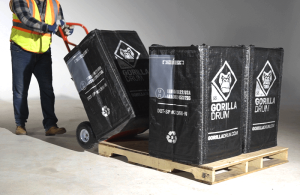 For decades, the 55 gallon hazmat drum has been the standard for hazardous waste storage and transport. Its size, durability, and availability made it the go-to solution for industrial, environmental, and chemical waste handling. But as regulations tighten and industries evolve, the traditional drum is showing its limitations.
For decades, the 55 gallon hazmat drum has been the standard for hazardous waste storage and transport. Its size, durability, and availability made it the go-to solution for industrial, environmental, and chemical waste handling. But as regulations tighten and industries evolve, the traditional drum is showing its limitations.
Today, many facilities are turning to advanced alternatives that offer improved safety, efficiency, and cost-effectiveness. Understanding what makes these new solutions better starts with recognizing the strengths and weaknesses of the classic 55 gallon drum and exploring modern innovations like collapsible, UN rated hazmat drums designed for today’s demanding waste management needs.
Gorilla Drum provides one such solution, offering a lightweight, collapsible, and fully compliant alternative that outperforms traditional drums in nearly every category.
The Legacy of the 55 Gallon Drum
The 55 gallon drum has long been the universal choice for storing and transporting hazardous waste. Made from steel, plastic, or composite materials, it’s used across industries for everything from chemical waste to contaminated soil and industrial sludge.
Commonly referred to as a hazardous waste drum, it remains an effective choice for many applications. However, its design comes with limitations that modern facilities are working to overcome. Traditional hazmat storage drums are:
-
Heavy and difficult to maneuver when full
-
Space-intensive when stored empty
-
Costly to clean, dispose of, or recondition
-
Susceptible to corrosion or damage over time
These challenges have driven innovation toward alternatives that maintain regulatory compliance while improving efficiency and reducing environmental impact.
For a detailed overview of the different types of traditional containers available, visit the 55 Gallon Drum Options For Hazardous Material Disposal resource.
The Limitations of Traditional Drums
Weight and Handling
A steel or polyethylene 55 gallon hazmat drum can weigh more than 40 pounds empty. When filled, it may exceed 400 pounds, making it difficult to move safely without mechanical equipment. This adds complexity and risk during transport and handling.
Storage Inefficiency
Empty drums take up significant warehouse space. Facilities that manage large waste volumes often face storage challenges, as traditional drums cannot be collapsed or stacked efficiently when unused.
Maintenance and Disposal Costs
Many drums require cleaning, inspection, or reconditioning before reuse. Those contaminated with hazardous materials must be disposed of following strict EPA and DOT guidelines—an expensive process that also generates additional waste.
Risk of Corrosion or Leakage
Steel drums, while durable, are prone to corrosion when exposed to certain chemicals or moisture. Plastic drums can warp under heat or pressure, compromising their integrity and increasing the risk of leaks.
What Makes a Better Alternative?
Modern waste management demands containers that are safe, efficient, and compliant without the drawbacks of traditional drums. Alternatives to 55 gallon drums for hazardous waste include collapsible hazmat containers made of reinforced polymers designed for heavy-duty industrial use.
These containers maintain full compliance with UN and DOT standards while solving common storage and transport problems.
Key benefits include:
-
Lightweight, flexible construction for easier handling
-
Collapsible design for compact storage when empty
-
Reinforced closures and walls to prevent leaks or punctures
-
Corrosion and chemical resistance
-
Compatibility with both liquids and solids
UN rated hazmat drums and DOT approved hazmat containers, like those from Gorilla Drum, combine safety and practicality to improve overall operational efficiency.
How Collapsible Drums Improve Safety and Efficiency
Easier Handling and Transport
Collapsible containers significantly reduce the physical strain associated with moving full drums. Features like lift loops, dolly straps, and ergonomic design make them easier to handle safely, even in confined spaces.
Reduced Storage Footprint
A major advantage of modern hazmat barrels is their ability to fold flat when empty. Facilities can store or transport dozens of empty containers in the space traditionally occupied by a single steel drum. This translates to lower warehouse costs and improved logistics.
Enhanced Spill Prevention
Gorilla Drum containers include reinforced zipper closures and internal supports that maintain shape and integrity during use. These features minimize the risk of leaks or spills during storage, handling, and transport.
Environmentally Friendly
By replacing disposable steel or plastic drums with reusable alternatives, facilities can reduce waste generation and minimize the environmental impact of their operations. Reusable containers also reduce the frequency of new drum purchases, leading to long-term cost savings.
Compliance Without Compromise
Safety and compliance remain top priorities in hazardous waste management. Containers used for chemical drum storage must meet or exceed standards for leakproofness, pressure resistance, and stacking strength.
UN rated hazmat drums and DOT approved hazmat containers undergo rigorous testing to confirm they meet international and domestic transport regulations. Gorilla Drum’s design ensures compliance across industries that handle hazardous waste, chemical manufacturing, or environmental cleanup operations.
Applications Beyond Hazardous Waste
While designed primarily for hazardous materials, these modern containers are also ideal for non-hazardous industrial materials, food-grade ingredients, and other bulk liquids or solids. Their lightweight yet durable construction makes them versatile across multiple sectors.
Common uses include:
-
Temporary chemical waste storage
-
Spill cleanup and remediation
-
Industrial byproduct collection
-
Recycling and environmental projects
This flexibility adds value for organizations looking to standardize their container systems without sacrificing compliance.
Choosing the Right Container for Your Facility
Every waste stream is unique, and selecting the correct container depends on the type of material, hazard classification, and handling method. Factors to consider include:
-
Physical state (liquid, solid, or sludge)
-
Chemical compatibility
-
Temperature sensitivity
-
Volume and frequency of disposal
-
Transport and storage conditions
For expert guidance, review the Guide To Choosing The Right Hazmat Drums For Waste Storage. This resource explains how to evaluate materials and container types for regulatory compliance and long-term efficiency.
Why Gorilla Drum Is the Better Alternative
Gorilla Drum represents a new generation of waste containment technology. Unlike rigid steel or plastic drums, it combines flexibility, strength, and portability in a single container.
Constructed from high-strength polypropylene, Gorilla Drum is fully UN and DOT compliant, offering superior resistance to chemicals and mechanical stress. Its collapsible design maximizes storage efficiency while maintaining reliable containment for liquids, solids, or mixed waste.
Key benefits include:
-
Collapsible frame for compact transport and storage
-
Reinforced zipper lid for spill prevention
-
Structural supports to maintain stability under load
-
Compatibility with forklifts, dollies, and lifting systems
-
Reusable, durable construction for long-term use
By upgrading to Gorilla Drum, facilities can simplify operations, improve safety, and reduce costs associated with traditional drums.
Final Thoughts
The 55 gallon drum has served industries well for decades, but modern waste management requires innovation that traditional designs can’t match. Collapsible, compliant alternatives like Gorilla Drum provide superior safety, efficiency, and environmental performance for handling hazardous and industrial waste.
To learn more or request information about safer, space-saving waste storage solutions, call +1 800-758-8079.

